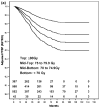What dose of external-beam radiation is high enough for prostate cancer?
- PMID: 17398026
- PMCID: PMC2770596
- DOI: 10.1016/j.ijrobp.2007.01.008
What dose of external-beam radiation is high enough for prostate cancer?
Abstract
Purpose: To quantify the radiotherapy dose-response of prostate cancer, adjusted for prognostic factors in a mature cohort of men treated relatively uniformly at a single institution.
Patients and methods: The study cohort consisted of 1,530 men treated with three-dimensional conformal external-beam radiotherapy between 1989 and 2002. Patients were divided into four isocenter dose groups: <70 Gy (n = 43), 70-74.9 Gy (n = 552), 75-79.9 Gy (n = 568), and > or =80 Gy (n = 367). The primary endpoints were freedom from biochemical failure (FFBF), defined by American Society for Therapeutic Radiology and Oncology (ASTRO) and Phoenix (nadir + 2.0 ng/mL) criteria, and freedom from distant metastases (FFDM). Multivariate analyses were performed and adjusted Kaplan-Meier estimates were calculated. Logit regression dose-response functions were determined at 5 and 8 years for FFBF and at 5 and 10 years for FFDM.
Results: Radiotherapy dose was significant in multivariate analyses for FFBF (ASTRO and Phoenix) and FFDM. Adjusted 5-year estimates of ASTRO FFBF for the four dose groups were 60%, 68%, 76%, and 84%. Adjusted 5-year Phoenix FFBFs for the four dose groups were 70%, 81%, 83%, and 89%. Adjusted 5-year and 10-year estimates of FFDM for the four dose groups were 96% and 93%, 97% and 93%, 99% and 95%, and 98% and 96%. Dose-response functions showed an increasing benefit for doses > or =80 Gy.
Conclusions: Doses of > or =80 Gy are recommended for most men with prostate cancer. The ASTRO definition of biochemical failure does not accurately estimate the effects of radiotherapy at 5 years because of backdating, compared to the Phoenix definition, which is less sensitive to follow-up and more reproducible over time.
Conflict of interest statement
Conflict of interest: none.
Figures



Comment in
-
Commentary on dose escalation and biochemical failure in prostate cancer: in regard to Eade et al. (Int. J. Radiat. Oncol. Biol. Phys. 2007;68:682-689).Int J Radiat Oncol Biol Phys. 2008 Feb 1;70(2):645; author reply 645-6. doi: 10.1016/j.ijrobp.2007.08.037. Int J Radiat Oncol Biol Phys. 2008. PMID: 18207038 No abstract available.
-
The need and prospect of individualized external beam radiotherapy dose escalation beyond 80 gy to treat prostate cancer: in regard to Eade et al. (Int J. Radiat. Oncol. Biol. Phys. 2007;68:682-689).Int J Radiat Oncol Biol Phys. 2008 Feb 1;70(2):645; author reply 645-6. doi: 10.1016/j.ijrobp.2007.08.001. Int J Radiat Oncol Biol Phys. 2008. PMID: 18207039 No abstract available.
-
Comment on dose escalation and biochemical failure in prostate cancer: in regard to Kuban et al. (Int J Radiat Oncol Biol Phys 2008;70:67-74).Int J Radiat Oncol Biol Phys. 2008 Jul 15;71(4):1288; author reply 1288-9. doi: 10.1016/j.ijrobp.2008.03.022. Int J Radiat Oncol Biol Phys. 2008. PMID: 18572089 No abstract available.
References
-
- Hanks GE, Hanlon AL, Epstein B, et al. Dose response in prostate cancer with 8–12 years’ follow-up. Int J Radiat Oncol Biol Phys. 2002;54:427–435. - PubMed
-
- Zelefsky MJ, Fuks Z, Hunt M, et al. High-dose intensity modulated radiation therapy for prostate cancer: early toxicity and biochemical outcome in 772 patients. Int J Radiat Oncol Biol Phys. 2002;53:1111–1116. - PubMed
-
- Pollack A, Hanlon AL, Horwitz EM, et al. Prostate cancer radiotherapy dose response: an update of the Fox Chase experience. J Urol. 2004;171:1132–1136. - PubMed
-
- Shipley WU, Verhey LJ, Munzenrider JE, et al. Advanced prostate cancer: the results of a randomized comparative trial of high dose irradiation boosting with conformal protons compared with conventional dose irradiation using photons alone. Int J Radiat Oncol Biol Phys. 1995;32:3–12. - PubMed
-
- Pollack A, Zagars GK, Starkschall G, et al. Prostate cancer radiation dose response: results of the M. D. Anderson phase III randomized trial. Int J Radiat Oncol Biol Phys. 2002;53:1097–1105. - PubMed
Publication types
MeSH terms
Grants and funding
LinkOut - more resources
Full Text Sources
Medical

